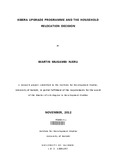| dc.description.abstract | This study examined factors considered by households in their decision to relocate or not to relocate to the new houses in the Kibera upgrade programme. In view of the contention in various studies that slum households relocation decision is based on consideration of affordability or in-affordability of new upgrade houses. Nonetheless, this study argued the relocation decision would be based on the consideration of more than one single factor. In order to establish its argument and determine the factors considered in the households overall relocation decision-making process. This study explored the socio-economic characteristics of households that relocated and those that did not relocate to the Kibera upgrade programme. The study examined the sociocultural and economic factors considered in decision to relocate or not to relocate. Finally, the study established the upgrade facility factors considered in the decision to relocate.
In order to establish its argument the study relied on primary and secondary sources of data and utilised literature review and sample surveys to obtain data from these sources. The data obtained was both quantitative and qualitative. Quantitative data was analysed through descriptive analysis procedures while thematic analysis approach was utilised to analyse qualitative data. The analysis enabled the study come up with findings that were comprehended through the cultural lens model as the study theoretical framework and the relocation decision-making model as the study conceptual framework. The findings revealed the myriad of factors considered in the decision to relocate or not to relocate. On the one hand, the relocated households considered factors like new house affordability, how regular they got their income to be able to pay for the new houses regularly, opportunity to do business for those who relied on business as a livelihood source. The relocated households also considered access to facilities like toilets, bathrooms, improved security and houses of better structural quality. On the other hand, the un-relocated households considered factors that included, affordability of slum houses in comparison to those at the upgrade, running businesses in the slums as ones livelihood source.
Moreover, the possibility of increase in fare with relocation, income irregularity and perceived higher chance of getting work opportunities while at the slum than at the upgrade. Relocation to the upgrade acknowledged by this study as the ideal situation in meeting the programme objectives and concurrent with the study findings. Recommendations are made to the programme developers with an emphasis to understand these factors considered in the decisions. Accordingly integrate them in project planning for subsequent phases of the upgrade. First, to ensure factors considered by relocated households are improved and consolidated and secondly to ensure the factors that led to slum households deciding not to relocate are incorporated in project planning. This in order to enhance uptake of new upgrade houses by those targeted in all subsequent phases and therefore lessen the number of slum households excluded in the slum upgrading process. | en_US |

